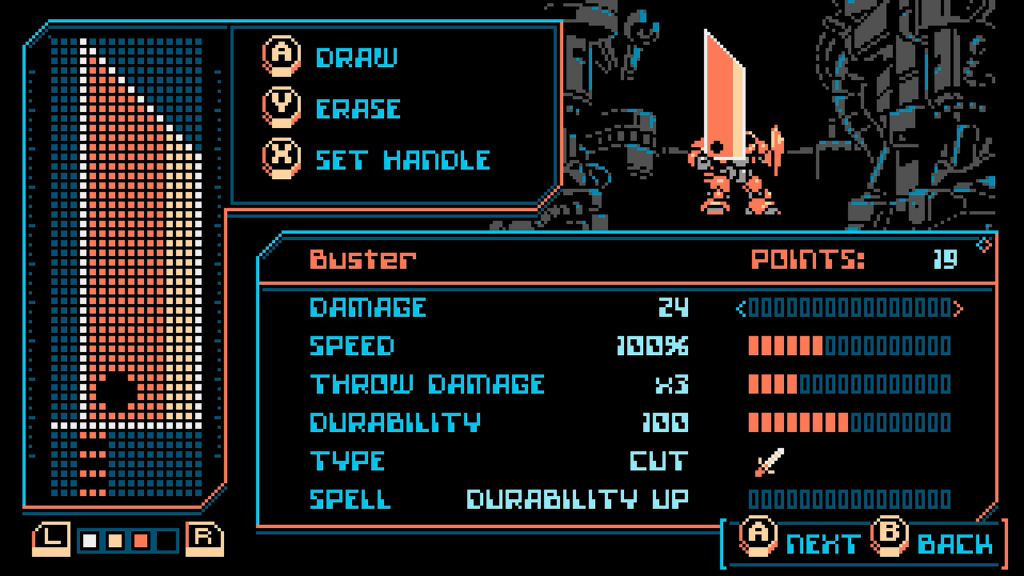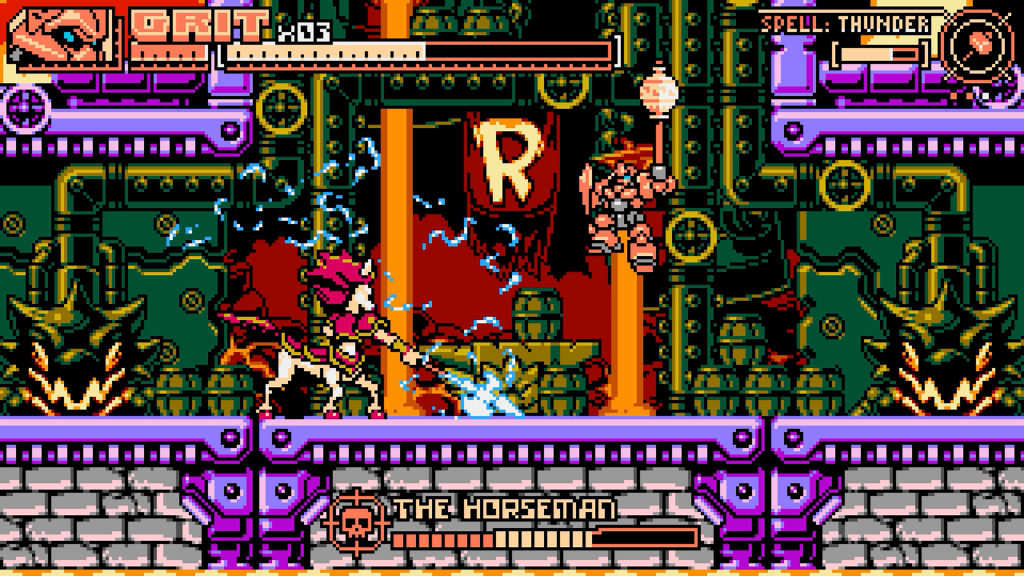One day in the near future every continent on Earth is impacted by weapon-shaped meteors. Unholy armies pour forth from these meteors, putting Earth’s nations under siege by their cultural demons: Greece is attacked by the gorgon Medusa, China must contend with the dragon Nian, while the United States is visited by the demon queen Lilith. But Earth has protectors: Gauntlet, an international defense development organization, recognizes the invasion as part of a prophecy that heralds the start of a cosmic war. They mobilize the rescue mission android Flame and a sentient suit of powered armor named GRIT to challenge the demon armies. Flame and GRIT globehop aboard the airship Avalon to stop the invasion, save the world, and avert an interdimensional war.

Panzer Paladin is a retro action-platformer inspired by late NES-era 8-bit videogames. I guide Flame and GRIT through seventeen levels set in countries around the world. Most of the adventure is spent controlling GRIT, a hulking knight with a versatile moveset using a huge arsenal of weapons. Aside from expected basic attacks to dispatch enemies, a thrust downward in the air lets him bounce off an enemy’s head, while a thrust upward gives him an extra boost higher, making his attacks as important for movement as for offense. Flame, GRIT’s diminutive pilot, can eject from her pilot’s seat to traverse levels on foot. She is able to slip into narrow gaps GRIT cannot, but is limited to a weak whip and a fraction of his hit points. These two playable characters with contrasting skillsets create a faithful retro action formula with enough refinements to make it stand on its own.
Depth and complexity is added to Panzer Paladin through a vast weapon system that affects nearly everything I do. As I defeat demonic soldiers, they may drop melee weapons themed to each level; massive two-handed zweihanders are found in Switzerland, vicious macuahuitls drop in Mexico, and ornate scepters appear in Russia.

Each weapon has different range, damage, and durability, and I may Break them to perform a spell. This consumes the weapon, but provides immediate effects like enhancing the durability of GRIT’s next weapon, restoring his health, or flooding the screen with lightning bolts. But weapons are used for more than just beating demons to death: Certain barriers leading to rare weapons can only be destroyed with specific weapon types; to activate a checkpoint, I must drive a weapon into a plinth; between levels, I can increase GRIT’s maximum hit points by breaking down weapons at Gauntlet’s laboratory.
There’s no shortage of ideas about what can be done with Panzer Paladin’s weapons, but I never fully understood one. After unlocking all of GRIT’s health upgrades, I found myself accumulating weapons faster than I could use them. My growing arsenal also increased a number on the weapon screen called a “Spirit Burden” which carries notifications like “danger level increased.” I infer from this that the difficulty increases as I stockpile more and more weapons, but Panzer Paladin already has a standard Easy/Normal/Hard difficulty selection before I begin. How GRIT’s Spirit Burden changes my experience is never clear or explained.

But I’m not limited to weapons the developers have included. Before I load my game, I can enter the Forge to craft my own. I can set my custom weapon’s power, durability, attacking speed, Break spell, and more by allocating a limited pool of points. If I choose to cap the weapon’s power or choose a powerful Break spell, it leaves fewer points to increase its durability or attack speed. This system is a bit obvious, but it works well. More impressive is that I am allowed to draw the weapon myself pixel-by-pixel, though I am regretfully restricted to a rather ugly color palette.
My customized weapons are added to a pool that drops randomly from The Horseman, a miniboss fought at each stage’s midpoint, and can also be uploaded online to potentially appear for other players. Long after I’ve seen everything else Panzer Paladin has to offer, there remains the possibility of some new and ridiculous weapon dropping from The Horseman to keep things fresh. In my playthrough I received a spiral-bladed sword with a candy cane stripe and a kasa-obake, among others. My only regret with these delightful and unexpected weapons is the durability system ensures I soon move to another, more mundane pickup.

The main use of these weapons is to crush the demon armies and their generals. Most enemies can be defeated with simple attacks, but others require more finesse as they block thoughtless attacks with a shield. I must watch if these elite mooks are blocking high or low and attack the other way to damage them. Elites will attack with telegraphed high and low attacks themselves, which GRIT can also block with his shield, or sometimes backstep to dodge the unblockable. As a non-combat rescue android, Flame does not possess these skills, making these duels intimidating obstacles if GRIT is not available. These same principles apply to bosses, some of whom duel GRIT one-on-one like the lesser demons. Others are rampaging beasts who charge around the screen dealing gleeful collision damage. As I so often write in reviews of retro side-scrollers, these combat systems punish button mashing but reward concentrated precision strikes. It’s as true and enjoyable here as it ever was.
Overall I have good experiences with Panzer Paladin, but it’s not flawless. Each level is restricted to a unique, limited color palette which makes them instantly recognizable, but also causes occasional difficulty in differentiating between the foreground and background. Multiple times I mistake a decoration for a platform and send GRIT plummeting down pits or onto spikes. This is a particular problem in the United States level. Another issue is at seventeen levels it’s simply too long, and just when the level select screen seems cleared an entire new batch appears. Either of these level sets would have been a satisfactory platformer by themselves. Lastly, it’s thematically confused, with the Good ending denouncing the wanton spread of destructive weapons before kicking me back to a menu featuring a Forge where destructive weapons can be designed and spread wantonly over the internet.

Panzer Paladin is a straightforward and competent retro platformer elevated by a robust weapon system and an admirably multicultural approach to its characters, objects, and settings; I can’t say how accurate these portrayals are, but the effort feels genuine rather than exploitative. There’s just enough lack of polish to make me wish it had spent a little more time in the workshop before release, but I enjoyed it anyway. It won’t convert the unconverted, but retro platformer fans will find something to enjoy and post-game speedrun and remix modes give it some life beyond the first credit roll. Flame and GRIT’s fight against the demon armies is worth hacking into.